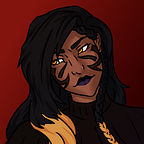Rez Mage is a new series wherein Mahpiya, a Dakota woman, takes Final Fantasy XIV far too seriously and over-analyses lore and story beats for themes of Indigeniety.
With the end of Final Fantasy 14’s second expansion, Stormblood, came a new player class: Blue Mage. Blue Mages, a regular across the franchise, have the ability to learn the actions taken by enemy monsters. These range from abilities used by the gods, able to kill enemies in a single blow, to the ability to self destruct, harming no one but themselves. Their powers are unique, strange, and always fun.
While they have appeared in multiple entries in the series, their style of magic finds a new origin with each new entry. In some it’s learned simply by observing monsters and copying what they do, in others it is the skill of an elite military order who inscribe the essence of monsters into their very souls. In Final Fantasy 14, it is the magic of the Whalaqee people, a nation from the far off “New World”.
Not much is known about what the New World really is. The player never directly interacts with it, only learning that explorers made contact in the year 1500 and that it’s wear the root vegetable “popotos” originated. The magic of the continent, according to the man who teaches it to the player, comes from a special ability the Whalaqee have to “attune the mind to the instinct of the beasts”. In doing so, they can take on some of the magic of monsters and “unleash the fury of nature”. This information is shared to the player not by a member of the Whalaqee, but by a man who claims to have visited the New World and is sharing his great “discoveries” with the people of his home continent. The magic of the New World is portrayed as something mysterious and primal, used by people who are uniquely in tune with the natural world around them.
You see where I’m going with this?
Once the player accepts the teachings of the explorer, he hands them a magical stone and sets them off to fight monsters across the continent and learn all the magic they can. Eventually, the player is brought news of tragedy. The expeditions to the new world that their new mentor has partook in has brought disease to the New World. The Whalaqee, particularly the elders, are suffering from a disease they have no natural immunities to and no knowledge of how to cure it. Luckily, this threat is wrapped up when our plucky white saviour mentor picks a few flowers to be made into medicine. Wow thanks, they’re cured.
It’s not long after that a second tragedy emerges. The lands of the Whalaqee lie on top of vast reserves of ceruleum, a magical type of fuel used to power technology across the Old World. Capitalists of the Old World have found out about this and through outright lies and unequal treaties with a now weakened nation have begun to force the Whalaqee off their lands so that they can extract this resource. To resolve this threat, the player challenges the company’s CEO to a wrestling match. If the player wins, the mining operation will stop and the treaties will be renegotiated. If the CEO wins, he gets carte blanche on all the land he sees fit. A single Whalaqee child is only one consulted about this arrangement. With all the magical skills the player has learned from the monsters they’ve encountered, they defeat the CEO and the Whalaqee are free.
What this all amounts to is missed opportunity. The world of Final Fantasy 14 is one of high fantasy. Cities are built into canopies of trees or in domes deep underwater. Floods of magic have spilled across the landscape, changing it irreparably. The instigating action of the game is when members of an ancient cult crash the literal moon, which had a dragon inside it, into the planet. It’s not exactly interested in telling grounded stories. So why does this plotline feature none of that? There’s the style of magic, sure, but everything surrounding the magic is an attempt at emulating real stories of colonialism. Instead of any showcases of fantastical events or wonderous accomplishments of the New World, we get a story taken out of a bad elementary school history textbook and a narrative where the Whalaqee are a footnote in their own story.
Throughout the experience of levelling a blue mage, the player is exposed to rudimentary, generalized tropes of the Indigenous peoples of North America: a people in tune with nature who are decimated by disease and have their lands stolen by people from across the sea. The Whalaqee as a people are near non-existent outside of this, the only other marker of their culture being the offensive and stereotypical “New World Attire” outfit. In this fantasy world full of wondrous magic and outlandish beings, the only representations of Indigenous peoples are stereotypes. The only stories they tell are ones that replicate our traumas. We do not get to exist as people, but as a literary device for others to look at and feel guilt over.
